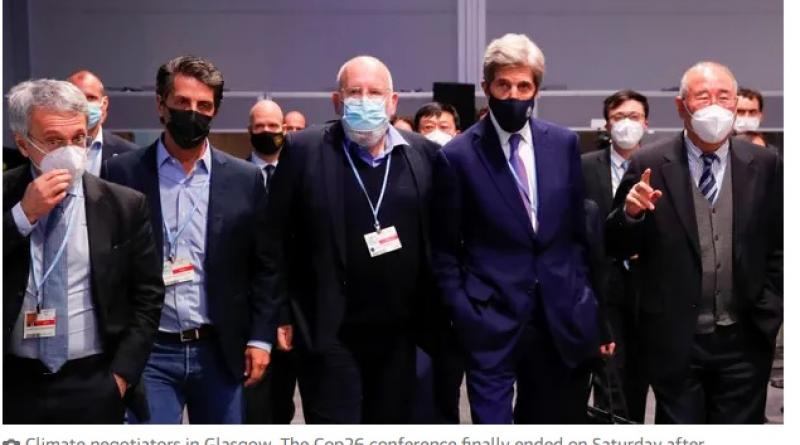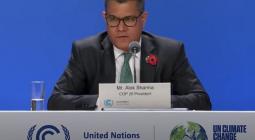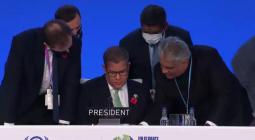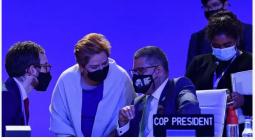What are the key points of the Glasgow climate pact?

Analysis: Cop26 delegates made progress on emissions cuts and climate adaptation but fell short on coal
The Cop26 climate conference finally came to an end on Saturday night, having overrun by a day. Here are the main points in the text agreed to by delegates.
Emissions cuts (known as mitigation)
Current national plans on cutting emissions by 2030, known as nationally determined contributions (NDCs), are inadequate to limit temperature rises to 1.5C, and according to analysis published during the talks would lead to a disastrous 2.4C of heating.
Only one major emitter – India – produced a new NDC at the talks, so the work of getting NDCs in line with a 1.5C goal was always going to stretch beyond the end of the Glasgow summit.
However, under the 2015 Paris agreement, nations are only required to return every five years to set new NDCs – and in 2025 are scheduled to discuss NDCs for beyond 2030. Sticking to that timetable would take the world well beyond 1.5C, so one of the crucial aims for the UK hosts was to draw up a roadmap for swifter revisions.
That was achieved – the question of revising NDCs will be on the agenda for next year’s Cop, to be held in Egypt, and for the one following in 2023.
This may seem like “kicking the can down the road”, but in fact provides those countries that want higher ambition on emissions cuts with an important lever to ensure laggard countries must step up. Glasgow was never going to be the endpoint in the process of tackling the climate crisis, so setting a roadmap for revisions next year, rather than several years away, is a good move.
Coal
Coal is the dirtiest fossil fuel and the International Energy Agency has made clear that if it is not rapidly phased out the world has no hope of staying within 1.5C of global heating. To hit the target, at least 40% of the world’s existing 8,500 coal-fired power plants must be closed by 2030 and no new ones built.
One of the hardest-fought phrases in the text produced at Glasgow was a commitment to “phase down” coal-fired power generation. Originally that was a phase-out, but India insisted on the change, despite pleas from other developing countries.
It may seem incredible, given how central fossil fuels are to the climate crisis, but since the Kyoto protocol was signed in 1997 no Cop decision has made a direct reference to phasing out fossil fuels. This reflects fierce opposition from oil-producing and coal-producing countries, and from those heavily dependent on consuming fossil fuels. This has stymied much progress at these talks, which rely on consensus for all decisions taken. So even the watered-down commitment was welcomed as a major step forward.
Adaptation and climate finance
Rich countries agreed in 2009 that poor countries would receive at least $100bn (£75bn) a year from 2020, from public and private sources, to help them cut emissions and cope with the impacts of the climate crisis. But by 2019, the latest year for which data is available, only $80bn flowed.
Developing countries are angered by this, which was reflected at the talks, and have been promised that increases will follow in the next five years that will bring the finance for the next five years to $500bn. Crucially, they also want more of the cash to be spent on adaptation, rather than emissions cuts.
This is important because most of the climate finance currently available goes to funding emissions-cutting projects, such as renewable energy schemes, in middle income countries that could often be funded easily without help, because they turn a profit. But the poorest countries who need money to adapt to the impact of extreme weather struggle to obtain any funding at all.
In the end, the text agreed to double the proportion of climate finance going to adaptation. The UN and some countries were calling for a 50:50 split between funding for emissions cuts and funding for adaptation, so this has fallen short but is still an important step.
Loss and damage
Loss and damage refers to the ravages of the climate crisis that are too destructive for countries to prevent or adapt to them – hurricanes and cyclones, for instance, or the inundation of low-lying areas by storm surges.
Countries have been talking about loss and damage for a decade but the discussions have made little progress. Developing countries say they are already spending large sums from their already stretched budgets to repair the damage caused by the climate crisis, but developed countries are wary of the way the discussion has sometimes been framed, as a call for compensation or reparations for climate damage, which they cannot accept as it would lay them open to endless legal liability.
At the last Cop, discussions moved on far enough for the setting up of a database and communications and reporting system, called the Santiago Network. Many developing countries were hoping that Cop26 could provide a further step, towards some form of funding mechanism for loss and damage. That has not happened, and the issue will return to the talks next year.
Reaffirming the Paris agreement
Some countries came to Glasgow opposed to stronger action and tried to suggest that focusing on 1.5C was “reopening the Paris agreement”, the main goal of which is to hold temperature rises “well below” 2C above pre-industrial levels while “pursuing efforts” to limit rises to 1.5C.
The UK hosts and supporters such as John Kerry of the US repeatedly pointed out that “well below” 2C could not mean 1.9C or 1.8C, as those were not “well below”, and that going below that got close to 1.5C. There are also repeated references in the text to “the best available science”, which has moved on since the Paris agreement to show even more clearly that 1.5C is much safer than 2C and that every fraction of a degree counts.
So the argument at Glasgow was firmly won in favour of 1.5C – in itself an achievement for the UK hosts, and much better for the planet.
THE GUARDIAN 14/11/2021




